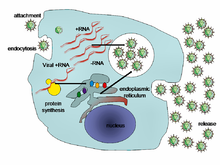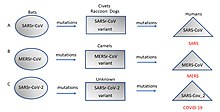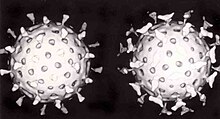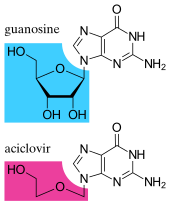Introduction to viruses
A virus is a tiny
Viruses are made of either two or three parts. All include genes. These genes contain the encoded biological information of the virus and are built from either DNA or RNA. All viruses are also covered with a protein coat to protect the genes. Some viruses may also have an envelope of fat-like substance that covers the protein coat, and makes them vulnerable to soap. A virus with this "viral envelope" uses it—along with specific receptors—to enter a new host cell. Viruses vary in shape from the simple helical and icosahedral to more complex structures. Viruses range in size from 20 to 300 nanometres; it would take 33,000 to 500,000 of them, side by side, to stretch to 1 centimetre (0.4 in).
Viruses spread in many ways. Although many are very specific about which host species or
Viruses, especially those made of RNA, can
Viral infections can cause disease in humans, animals and plants. In healthy humans and animals, infections are usually eliminated by the
Discovery

In 1884, French microbiologist Charles Chamberland invented the Chamberland filter (or Chamberland–Pasteur filter), that contains pores smaller than bacteria. He could then pass a solution containing bacteria through the filter, and completely remove them. In the early 1890s, Russian biologist Dmitri Ivanovsky used this method to study what became known as the tobacco mosaic virus. His experiments showed that extracts from the crushed leaves of infected tobacco plants remain infectious after filtration.[2]
At the same time, several other scientists showed that, although these agents (later called viruses) were different from bacteria and about one hundred times smaller, they could still cause disease. In 1899, Dutch microbiologist
The invention of the
A problem for early scientists was that they did not know how to grow viruses without using live animals. The breakthrough came in 1931, when American
Origins
Viruses co-exist with life wherever it occurs. They have probably existed since living cells first evolved. Their origin remains unclear because they do not fossilize, so molecular techniques have been the best way to hypothesise about how they arose. These techniques rely on the availability of ancient viral DNA or RNA, but most viruses that have been preserved and stored in laboratories are less than 90 years old.[13][14] Molecular methods have only been successful in tracing the ancestry of viruses that evolved in the 20th century.[15] New groups of viruses might have repeatedly emerged at all stages of the evolution of life.[16] There are three major theories about the origins of viruses:[16][17]
- Regressive theory
- Viruses may have once been small cells that Chlamydia are living cells that, like viruses, can reproduce only inside host cells. This lends credence to this theory, as their dependence on being parasites may have led to the loss of the genes that once allowed them to live on their own.[18]
- Cellular origin theory
- Some viruses may have evolved from bits of DNA or RNA that "escaped" from the genes of a larger organism. The escaped DNA could have come from plasmids—pieces of DNA that can move between cells—while others may have evolved from bacteria.[19]
- Coevolution theory
- Viruses may have evolved from complex molecules of protein and DNA at the same time as cells first appeared on earth, and would have depended on cellular life for many millions of years.[20]
There are problems with all of these theories. The regressive hypothesis does not explain why even the smallest of cellular parasites do not resemble viruses in any way. The escape or the cellular origin hypothesis does not explain the presence of unique structures in viruses that do not appear in cells. The coevolution, or "virus-first" hypothesis, conflicts with the definition of viruses, because viruses depend on host cells.[20][21] Also, viruses are recognised as ancient, and to have origins that pre-date the divergence of life into the three domains.[22] This discovery has led modern virologists to reconsider and re-evaluate these three classical hypotheses.[16][22]
Structure

A virus particle, also called a
Size

Viruses are among the smallest infectious agents, and are too small to be seen by
Genes
The genes of viruses are made from DNA (deoxyribonucleic acid) and, in many viruses, RNA (ribonucleic acid). The biological information contained in an organism is encoded in its DNA or RNA. Most organisms use DNA, but many viruses have RNA as their genetic material. The DNA or RNA of viruses consists of either a single strand or a double helix.[28]
Viruses can reproduce rapidly because they have relatively few genes. For example, influenza virus has only eight genes and rotavirus has eleven. In comparison, humans have 20,000–25,000. Some viral genes contain the code to make the structural proteins that form the virus particle. Other genes make non-structural proteins found only in the cells the virus infects.[29][30]
All cells, and many viruses, produce proteins that are enzymes that drive chemical reactions. Some of these enzymes, called DNA polymerase and RNA polymerase, make new copies of DNA and RNA. A virus's polymerase enzymes are often much more efficient at making DNA and RNA than the equivalent enzymes of the host cells,[31] but viral RNA polymerase enzymes are error-prone, causing RNA viruses to mutate and form new strains.[32]
In some species of RNA virus, the genes are not on a continuous molecule of RNA, but are separated. The influenza virus, for example, has eight separate genes made of RNA. When two different strains of influenza virus infect the same cell, these genes can mix and produce new strains of the virus in a process called reassortment.[33]
Protein synthesis
Proteins are essential to life. Cells produce new protein molecules from
Transcription is the process where information in DNA, called the genetic code, is used to produce RNA copies called messenger RNA (mRNA). These migrate through the cell and carry the code to ribosomes where it is used to make proteins. This is called translation because the protein's amino acid structure is determined by the mRNA's code. Information is hence translated from the language of nucleic acids to the language of amino acids.[34]
Some nucleic acids of RNA viruses function directly as mRNA without further modification. For this reason, these viruses are called positive-sense RNA viruses.[35] In other RNA viruses, the RNA is a complementary copy of mRNA and these viruses rely on the cell's or their own enzyme to make mRNA. These are called negative-sense RNA viruses. In viruses made from DNA, the method of mRNA production is similar to that of the cell. The species of viruses called retroviruses behave completely differently: they have RNA, but inside the host cell a DNA copy of their RNA is made with the help of the enzyme reverse transcriptase. This DNA is then incorporated into the host's own DNA, and copied into mRNA by the cell's normal pathways.[36]
Life-cycle

When a virus infects a cell, the virus forces it to make thousands more viruses. It does this by making the cell copy the virus's DNA or RNA, making viral proteins, which all assemble to form new virus particles.[37]
There are six basic, overlapping stages in the life cycle of viruses in living cells:[38]
- Attachment is the binding of the virus to specific molecules on the surface of the cell. This specificity restricts the virus to a very limited type of cell. For example, the human immunodeficiency virus (HIV) infects only human gp120, can only react with CD4and other molecules on the T cell's surface. Plant viruses can only attach to plant cells and cannot infect animals. This mechanism has evolved to favour those viruses that only infect cells in which they are capable of reproducing.
- Penetration follows attachment; viruses penetrate the host cell by endocytosis or by fusion with the cell.
- Uncoating happens inside the cell when the viral capsid is removed and destroyed by viral enzymes or host enzymes, thereby exposing the viral nucleic acid.
- Replication of virus particles is the stage where a cell uses viral messenger RNA in its protein synthesis systems to produce viral proteins. The RNA or DNA synthesis abilities of the cell produce the virus's DNA or RNA.
- Assembly takes place in the cell when the newly created viral proteins and nucleic acid combine to form hundreds of new virus particles.
- Release occurs when the new viruses escape or are released from the cell. Most viruses achieve this by making the cells burst, a process called lysis. Other viruses such as HIV are released more gently by a process called budding.
Effects on the host cell
Viruses have an extensive range of structural and biochemical effects on the host cell.[39]These are called cytopathic effects.[40] Most virus infections eventually result in the death of the host cell. The causes of death include cell lysis (bursting), alterations to the cell's surface membrane and apoptosis (cell "suicide").[41] Often cell death is caused by cessation of its normal activity due to proteins produced by the virus, not all of which are components of the virus particle.[42]
Some viruses cause no apparent changes to the infected cell. Cells in which the virus is
Some viruses, such as
Viruses and diseases
There are many ways in which viruses spread from host to host but each species of virus uses only one or two. Many viruses that infect plants are carried by
In humans
Common human diseases caused by viruses include the
Endemic
If the proportion of carriers in a given population reaches a given threshold, a disease is said to be
Pandemic and emergent

Although viral pandemics are rare events, HIV—which evolved from viruses found in monkeys and chimpanzees—has been pandemic since at least the 1980s.[62] During the 20th century there were four pandemics caused by influenza virus and those that occurred in 1918, 1957 and 1968 were severe.[63] Before its eradication, smallpox was a cause of pandemics for more than 3,000 years.[64] Throughout history, human migration has aided the spread of pandemic infections; first by sea and in modern times also by air.[65]
With the exception of smallpox, most pandemics are caused by newly evolved viruses. These "emergent" viruses are usually mutants of less harmful viruses that have circulated previously either in humans or in other animals.[66]
A related coronavirus emerged in
In plants

There are many types of
Bacteriophages

Bacteriophages are viruses that infect bacteria and
Host resistance
Innate immunity of animals
Animals, including humans, have many natural defences against viruses. Some are non-specific and protect against many viruses regardless of the type. This innate immunity is not improved by repeated exposure to viruses and does not retain a "memory" of the infection. The skin of animals, particularly its surface, which is made from dead cells, prevents many types of viruses from infecting the host. The acidity of the contents of the stomach destroys many viruses that have been swallowed. When a virus overcomes these barriers and enters the host, other innate defences prevent the spread of infection in the body. A special hormone called interferon is produced by the body when viruses are present, and this stops the viruses from reproducing by killing the infected cells and their close neighbours. Inside cells, there are enzymes that destroy the RNA of viruses. This is called RNA interference. Some blood cells engulf and destroy other virus-infected cells.[78]
Adaptive immunity of animals

Specific immunity to viruses develops over time and white blood cells called lymphocytes play a central role. Lymphocytes retain a "memory" of virus infections and produce many special molecules called antibodies. These antibodies attach to viruses and stop the virus from infecting cells. Antibodies are highly selective and attack only one type of virus. The body makes many different antibodies, especially during the initial infection. After the infection subsides, some antibodies remain and continue to be produced, usually giving the host lifelong immunity to the virus.[79]
Plant resistance
Plants have elaborate and effective defence mechanisms against viruses. One of the most effective is the presence of so-called resistance (R) genes. Each R gene confers resistance to a particular virus by triggering localised areas of cell death around the infected cell, which can often be seen with the unaided eye as large spots. This stops the infection from spreading.[80] RNA interference is also an effective defence in plants.[81] When they are infected, plants often produce natural disinfectants that destroy viruses, such as salicylic acid, nitric oxide and reactive oxygen molecules.[82]
Resistance to bacteriophages
The major way bacteria defend themselves from bacteriophages is by producing enzymes which destroy foreign DNA. These enzymes, called
Prevention and treatment of viral disease
Vaccines

Vaccines simulate a natural infection and its associated immune response, but do not cause the disease. Their use has resulted in the eradication of smallpox and a dramatic decline in illness and death caused by infections such as polio, measles, mumps and rubella.[84] Vaccines are available to prevent over fourteen viral infections of humans[85] and more are used to prevent viral infections of animals.[86] Vaccines may consist of either live or killed viruses.[87] Live vaccines contain weakened forms of the virus, but these vaccines can be dangerous when given to people with weak immunity. In these people, the weakened virus can cause the original disease.[88] Biotechnology and genetic engineering techniques are used to produce "designer" vaccines that only have the capsid proteins of the virus. Hepatitis B vaccine is an example of this type of vaccine.[89] These vaccines are safer because they can never cause the disease.[87]
Antiviral drugs

Since the mid-1980s, the development of antiviral drugs has increased rapidly, mainly driven by the AIDS pandemic. Antiviral drugs are often nucleoside analogues, which masquerade as DNA building blocks (nucleosides). When the replication of virus DNA begins, some of the fake building blocks are used. This prevents DNA replication because the drugs lack the essential features that allow the formation of a DNA chain. When DNA production stops the virus can no longer reproduce.[90] Examples of nucleoside analogues are aciclovir for herpes virus infections and lamivudine for HIV and hepatitis B virus infections. Aciclovir is one of the oldest and most frequently prescribed antiviral drugs.[91]
Other antiviral drugs target different stages of the viral life cycle. HIV is dependent on an enzyme called the
Hepatitis C is caused by an RNA virus. In 80% of those infected, the disease becomes
HIV infections are usually treated with a combination of antiviral drugs, each targeting a different stage in the virus's life cycle. There are drugs that prevent the virus from attaching to cells, others that are nucleoside analogues and some poison the virus's enzymes that it needs to reproduce. The success of these drugs is proof of the importance of knowing how viruses reproduce.[92]
Role in ecology
Viruses are the most abundant biological entity in aquatic environments;[95] one teaspoon of seawater contains about ten million viruses,[96] and they are essential to the regulation of saltwater and freshwater ecosystems.[97] Most are bacteriophages,[98] which are harmless to plants and animals. They infect and destroy the bacteria in aquatic microbial communities and this is the most important mechanism of recycling carbon in the marine environment. The organic molecules released from the bacterial cells by the viruses stimulate fresh bacterial and algal growth.[99]
Microorganisms constitute more than 90% of the biomass in the sea. It is estimated that viruses kill approximately 20% of this biomass each day and that there are fifteen times as many viruses in the oceans as there are bacteria and archaea. They are mainly responsible for the rapid destruction of harmful algal blooms,[100] which often kill other marine life.[101] The number of viruses in the oceans decreases further offshore and deeper into the water, where there are fewer host organisms.[102]
Their effects are far-reaching; by increasing the amount of respiration in the oceans, viruses are indirectly responsible for reducing the amount of carbon dioxide in the atmosphere by approximately 3
Marine mammals are also susceptible to viral infections. In 1988 and 2002, thousands of harbour seals were killed in Europe by
Viruses can also serve as an alternative food source for microorganisms which engage in
See also
References
Notes
- ^ S2CID 21670772.
- ^ Shors 2017, p. 6
- ^ Collier, Balows & Sussman 1998, p. 3
- ^ Shors 2017, p. 827
- PMID 17855060.
- ^ From Nobel Lectures, Physics 1981–1990, (1993) Editor-in-Charge Tore Frängsmyr, Editor Gösta Ekspång, World Scientific Publishing Co., Singapore
- PMID 17756690.
- PMID 17788438.
- S2CID 25741967.
- ^ Johnson B (25 July 2017). "Rosalind Franklin's contributions to virology". Nature Portfolio Microbiology Community. Retrieved 7 January 2022.
- PMID 17810781.
- PMID 15470207.
- ^ Shors 2017, p. 16
- ^ Collier, Balows & Sussman 1998, pp. 18–19
- PMID 15476878.
- ^ S2CID 169035711.
- ^ Collier, Balows & Sussman 1998, pp. 11–21
- ^ Collier, Balows & Sussman 1998, p. 11
- ^ Collier, Balows & Sussman 1998, pp. 11–12
- ^ a b Wessner DR (2010). "The Origins of Viruses". Nature Education. 3 (9): 37.
- PMID 23550145.
- ^ ISBN 978-0-12-375146-1.
- ^ a b Collier, Balows & Sussman 1998, pp. 33–55
- PMID 11759024.
- PMID 26391910.
- S2CID 16877147.
- ^ Zimmer C (18 July 2013). "Changing View on Viruses: Not So Small After All". The New York Times. Retrieved 20 December 2014.
- ^ Shors 2017, p. 81
- ^ Shors 2017, p. 129
- S2CID 186242248.
- ^ Shors 2017, pp. 129–31
- ^ Shors 2017, p. 652
- ^ Shors 2017, p. 654
- ^ PMID 25648499.
- ^ Collier, Balows & Sussman 1998, pp. 75–82
- ^ Shors 2017, p. 698
- ^ Shors 2017, pp. 6–13
- ^ Shors 2017, pp. 121–123
- ^ Oxford, Kellam & Collier 2016, p. 34–36.
- ^ Oxford, Kellam & Collier 2016, p. 34.
- PMID 28846635.
- PMID 18637511.
- PMID 18164651.
- PMID 6326635.
- S2CID 24879226.
- PMID 18035323.
- PMID 28798073.
- PMID 10547702.
- ^ Shors 2017, p. 32
- ^ Shors 2017, p. 271
- PMID 23516359.
- ^ Shors 2017, p. 464
- PMID 31364248.
- PMID 32173241.
- ^ Oxford, Kellam & Collier 2016, p. 63.
- S2CID 49640682.
- PMID 22958213.
- PMID 25777068.
- PMID 25444814.
- PMID 32103776.
- ^ PMID 32143502.
- PMID 29460740.
- PMID 30180422.
- S2CID 37149836.
- PMID 30878442.
- ^ "Virology Journal". Virology Journal.
- PMID 22094080.
- PMID 28475794.
- ^ Report of the WHO-China Joint Mission on Coronavirus Disease 2019 (COVID-19) (PDF) (Report). World Health Organization (WHO). 16–24 February 2020. Retrieved 21 March 2020.
- PMID 32093211.
- PMID 32109444.
- ^ Londoño E, Ortiz A (16 March 2020). "Coronavirus Travel Restrictions, Across the Globe". The New York Times – via NYTimes.com.
- ^ "US takes more big pandemic response steps; Europe COVID-19 cases soar". CIDRAP. 15 March 2020.
- ^ Shors 2017, p. 822
- ^ Shors 2017, pp. 802–803
- ^ Oxford, Kellam & Collier 2016, p. 19.
- ^ Shors 2017, p. 803
- ^ Shors 2017, pp. 116–117
- ^ Shors 2017, pp. 225–233
- PMID 30201857.
- ^ Shors 2017, p. 812
- S2CID 27311732.
- S2CID 17960960. Archived from the original(PDF) on 27 March 2020.
- ^ Shors 2017, pp. 237–255
- PMID 22003377.
- PMID 28618246.
- ^ a b Shors 2017, p. 237
- PMID 1090805.
- ^ Shors 2017, p. 238
- ^ Shors 2017, pp. 514–515
- ^ Shors 2017, p. 514
- ^ a b Shors 2017, p. 568
- PMID 28319996.
- PMID 21654909.
- PMID 16984643.
- PMID 31749771.
- ^ Shors 2017, p. 5
- S2CID 46927784.
- ^ Shors 2017, pp. 25–26
- S2CID 4370363.
- ^ "Harmful Algal Blooms: Red Tide: Home | CDC HSB". www.cdc.gov. Retrieved 23 August 2009.
- ^ S2CID 4658457.
- .
- PMID 36574690.
- ^ Irving M (28 December 2022). "First "virovore" discovered: An organism that eats viruses". New Atlas. Archived from the original on 29 December 2022. Retrieved 29 December 2022.
Bibliography
- Collier L, Balows A, Sussman M, eds. (1998). Topley & Wilson's Microbiology and Microbial Infections. Vol. 1, Virology (9th ed.). Arnold. ISBN 0-340-66316-2.
- Oxford J, Kellam P, Collier L (2016). Human Virology. Oxford: Oxford University Press. OCLC 968152575.
- Shors T (2017). Understanding Viruses. Jones and Bartlett Publishers. ISBN 978-1284025927.
External links
- Virus Pathogen Resource – Genomic and other research data about human pathogenic viruses
- Influenza Research Database – Genomic and other research data about influenza viruses

